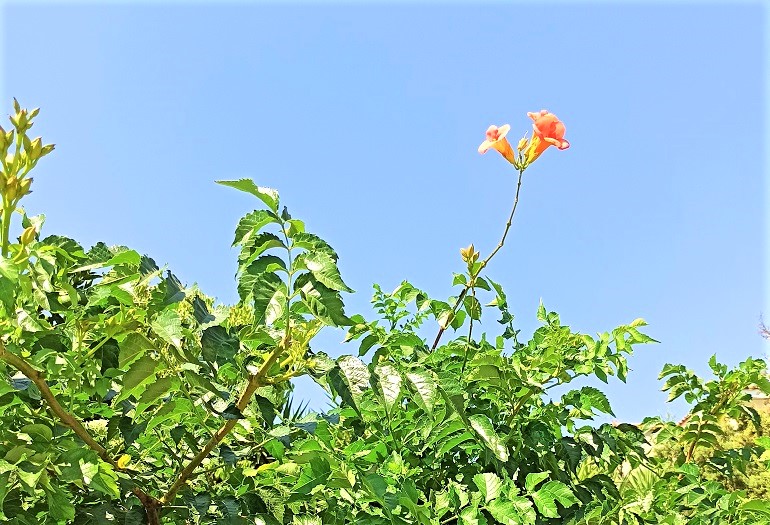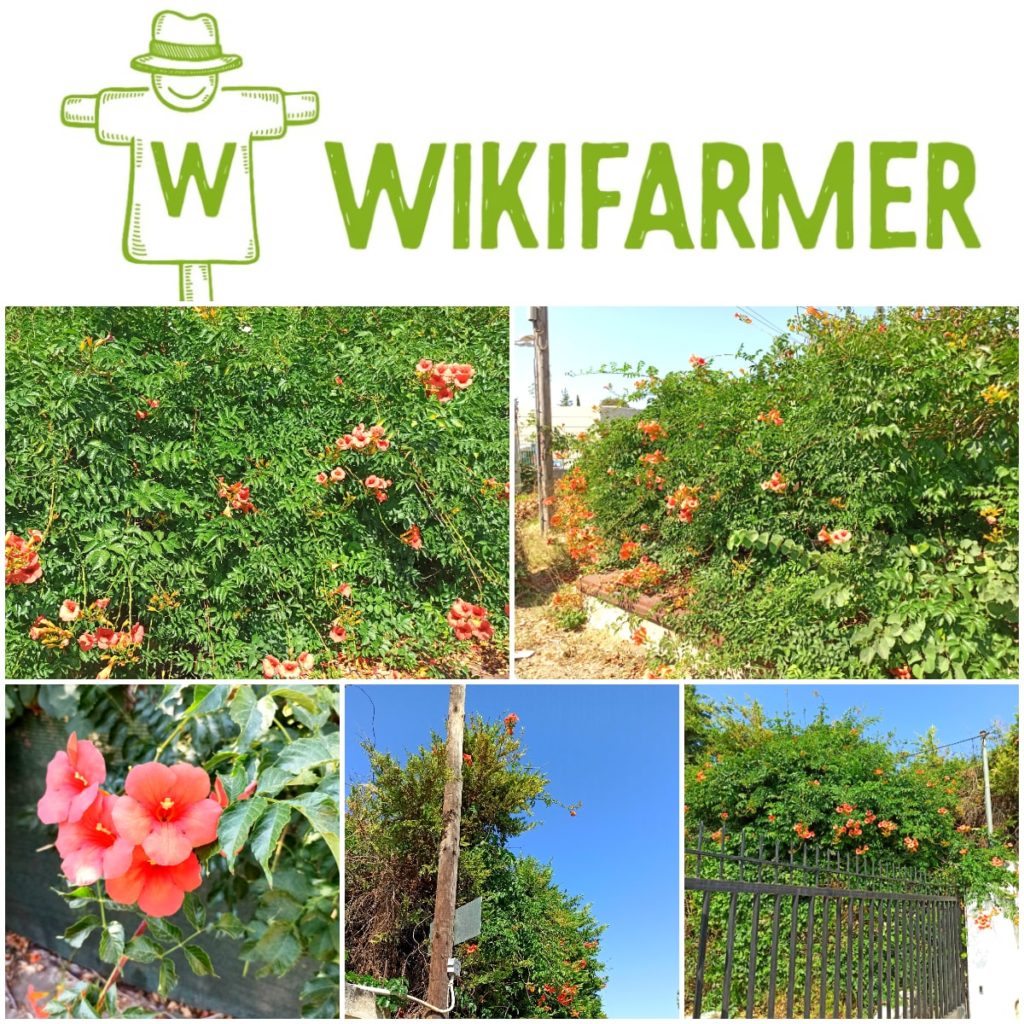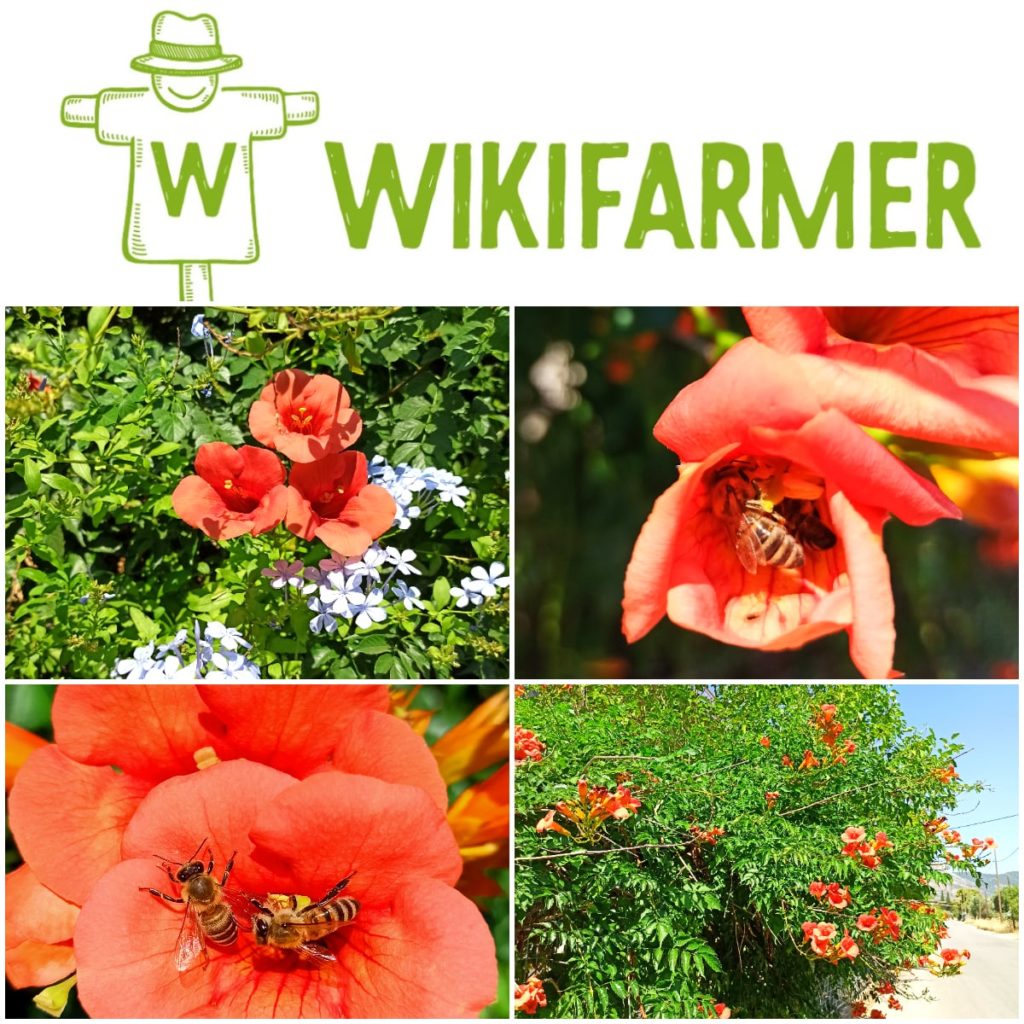Bignonia

This post is also available in:
This post is also available in:
![]() Français (French)
Français (French) ![]() Deutsch (German)
Deutsch (German) ![]() Nederlands (Dutch)
Nederlands (Dutch) ![]() हिन्दी (Hindi)
हिन्दी (Hindi) ![]() العربية (Arabic)
العربية (Arabic) ![]() 简体中文 (Chinese (Simplified))
简体中文 (Chinese (Simplified)) ![]() Italiano (Italian)
Italiano (Italian) ![]() 한국어 (Korean)
한국어 (Korean)
Vivid vegetation spread over yards’ fences, decorated with orange bell-shaped flowers visited by bees. This description refers to none other than the well-known Bignonia or Chinese trumpet vine.
Many begnonia varieties exist that can be evergreen or deciduous or differ in size, the shape of flowers, and their climbing ability. The most widespread variety, especially in Mediterranean countries, is the versatile Bignonia grandiflora, originating from East Asia. This deciduous Bignonia is a fast-growing climbing plant with large, orange, trumpet-shaped flowers. It can reach a height of ten meters (32.8 feet) or more, exploiting other trees (e.g., coniferous) or light poles as support to climb. The plant is very popular as a natural hedge in many countries, thanks to its fast growth rate and rich foliage. It is very common to use Begnonias to cover walls, fences, pergolas, or even rocky ground surfaces. Many gardeners or plant enthusiasts create colorful plant fences by combining Bignonia (bright orange flowers) with plumbago (flowers in sea color) and bougainvillea (pink, red and white flowers).
Bignonia can grow both in pots and in the soil. Under ideal environmental conditions, the plants need minimal care, after 1-2 years. However, even in these cases, we need to prune our plants yearly.
The 6 points we need to take care of when we grow a Bignonia plant:
Plant Purchase and Selection of Planting Spot for Bignonia.
Our journey begins with the purchase of Bignonia from the nearest plant nursery. The price of 1.5 meters (5 feet) tall plant is usually around 12 euros (14 dollars). Next, we need to find a protected spot to either plant it (on the ground) or place the pot. The plant can grow in semi-shady places but will produce significantly fewer flowers. If we want dense foliage growth and the same time, intense flowering, we should place the plant in a spot with direct access to sunlight for several hours a day. In terms of soil, the plant is very versatile and will adapt to any well-drained soil type.
Bignonia’s Water Requirements – Irrigation Of Bignonias
Older Bignonias are very resistant to drought, but we need to regularly water the younger plants and plants growing in pots during summer. Even well-established plants will perform better if watered during prolonged periods of drought. Be careful to water the Bignonias when the soil is arid, as excessive soil moisture can cause root rot.
 Pruning of Bignonias
Pruning of Bignonias
In a high-speed growing plant with powerful climbing ability, such as Bignonia, pruning is critical. Proper pruning can give the plant the shape we want, encourage it to grow in a specific direction, and control excessive vegetation. If we don’t control its growth in time, it can get quickly out of control and suffocate neighboring plants.
Bignonia requires pruning yearly at the beginning of spring. The plant blooms in new vegetation, and therefore a strict pruning can promote the formation of fresh flowers.
Many people, however, perform an initial pruning immediately after planting-transplanting. During this pruning, they cut all the shoots at the height of 15 cm (0.5 feet) from the ground. When they start to grow, the gardeners pick the most vigorous four or five shoots and remove the rest. Similarly, all weak, dry, diseased, and underdeveloped shoots are constantly removed.
A mature, well-formed Bignonia is usually a plant with branches reaching 4 meters in height. This process usually takes two to three years.
To keep our plant in good shape and under control, to ensure a sufficient airflow inside the plant’s canopy and encourage flowering, we must prune the lateral shoots well before every growing season. The pruning shears we will use during the deadheading must be of high quality and accompanied by the corresponding certificates.
Personal safety during pruning
Several people have reported skin irritations and itching after contact with the foliage of Bignonia. If we have decided to grow a Bignonia on our terrace or garden, we probably need to buy special gloves to protect us during gardening.
 Fertilization of Bignonia
Fertilization of Bignonia
The first two years after planting, we can promote vegetative growth (at the expense of flowering) by adding a balanced granular fertilizer (e.g., NPK 7-7-7) twice a year, once in spring and once in summer. We can also add a water-soluble fertilizer (7-7-7), to the plants growing in pots, twice during the growing season (spring and summer). Τhe exact dosage of each fertilizer is reported by the manufacturer on the product’s label. In most cases, we can add three caps to a 3-liter watering can and water two pots with the solution.
Maturation
Bignonia requires minimum care from the third year of planting onwards. We can water only in prolonged dry periods and never fertilize the plants again. The most crucial maintenance action is to prune aggressively from time to time to keep the plant under control, so it does not choke neighboring plants. Except for ants, Bignonia does not face significant threats from diseases and pests.









































































